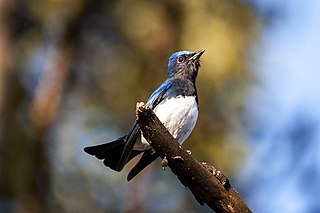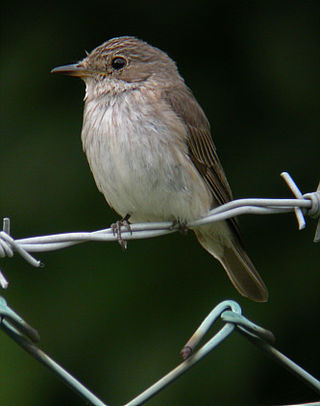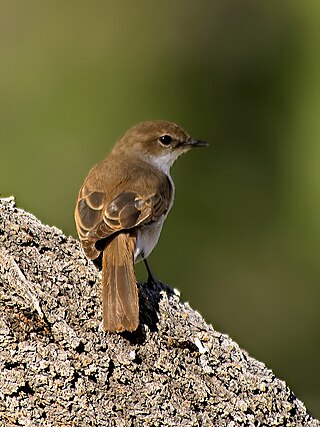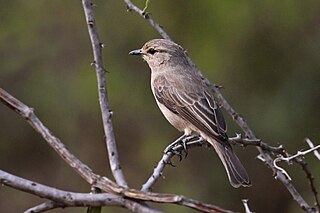
The thrushes are a passerine bird family, Turdidae, with a worldwide distribution. The family was once much larger before biologists reclassified the former subfamily Saxicolinae, which includes the chats and European robins, as Old World flycatchers. Thrushes are small to medium-sized ground living birds that feed on insects, other invertebrates, and fruit. Some unrelated species around the world have been named after thrushes due to their similarity to birds in this family.

The Old World flycatchers are a large family, the Muscicapidae, of small passerine birds restricted to the Old World, with the exception of several vagrants and two species, bluethroat and northern wheatear, found also in North America. These are mainly small arboreal insectivores, many of which, as the name implies, take their prey on the wing. The family is relatively large and includes 357 species, which are divided into 54 genera.

The blue-and-white flycatcher is a migratory songbird in the Old World flycatcher family Muscicapidae. The species is also known as the Japanese flycatcher. It breeds in Japan, Korea, and in parts of north eastern China and the Russian Far East. It winters in South East Asia, especially in Vietnam, Cambodia, Thailand, Sumatra and Borneo. This species has been recorded as a vagrant from the Sinharaja Rainforest in Sri Lanka in 2014.

Melaenornis is a genus of small passerine birds in the large family Muscicapidae commonly known as the Old World flycatchers. They are restricted to sub-Saharan Africa.

Muscicapa is a genus of passerine birds belonging to the Old World flycatcher family Muscicapidae, and therein to the typical flycatchers of subfamily Muscicapinae. They are widespread across Europe, Africa and Asia with most species occurring in forest and woodland habitats. Several species are migratory, moving south from Europe and northern Asia for the winter.

The Nilgiri blue robin, also known as Nilgiri shortwing, white-bellied shortwing, Nilgiri sholakili or rufous-bellied shortwing is a species of passerine bird in the family Muscicapidae endemic to the Shola forests of the higher hills of southern India, mainly north of the Palghat Gap. This small bird is found on the forest floor and undergrowth of dense forest patches sheltered in the valleys of montane grassland, a restricted and threatened habitat.

The chat flycatcher is a small passerine bird in the Old World flycatcher family Muscicapidae that is native to southern Africa.

The Marico flycatcher or Mariqua flycatcher is a passerine bird in the Old World flycatcher family Muscicapidae that is found in areas of southern Africa.

The African grey flycatcher, grayish flycatcher, or large flycatcher is a passerine bird in the Old World flycatcher family Muscicapidae that occurs in parts of East Africa.

The pale flycatcher is a passerine bird of the Old World flycatcher family Muscicapidae, found in Sub-Saharan Africa.

Cyornis is a genus of birds in the Old World flycatcher family Muscicapidae most of which are native to Southeast Asia.

Eumyias is a genus of birds in the Old World flycatcher family Muscicapidae.

Niltava is a genus of passerine birds in the Old World flycatcher family Muscicapidae. They are found in found in South and Southeast Asia as well as in China. The seven species in the genus are sexually dimorphic. The males have blue upperparts and all except the large niltava have orange-rufous underparts. The females are less brightly coloured and have brown upperparts and buffish underparts.

The Buru jungle flycatcher, also known as the streak-breasted jungle-flycatcher or streaky-breasted jungle-flycatcher, is a species of bird in the Old World flycatcher family Muscicapidae. It is endemic to the island of Buru in Indonesia where it originally inhabited tropical forests at elevations between 500 and 1,500 metres.

The brown-chested jungle flycatcher is a species of bird in the Old World flycatcher family Muscicapidae. It breeds in South China and winters in the Malay Peninsula. Its natural habitats are subtropical or tropical moist lowland forests and subtropical or tropical mangrove forests. It is threatened by habitat loss.

The fulvous-chested jungle flycatcher is a species of bird in the Old World flycatcher family Muscicapidae. It is found in Brunei, Indonesia, Malaysia, Myanmar, and Thailand. Its natural habitat is subtropical or tropical moist lowland forests.

The grey-chested jungle flycatcher is a species of bird in the Old World flycatcher family Muscicapidae. It is found in Brunei, Indonesia, Malaysia, and Thailand. Its natural habitats are subtropical or tropical moist lowland forests and subtropical or tropical swamps. It is threatened by habitat loss.

The Angola cave chat is a small passerine bird in the Old World flycatcher family Muscicapidae. It is the sole member of the monotypic genus Xenocopsychus; although it was placed in Cossypha between 2010 and 2022 based on the results of a 2010 molecular phylogenetic study, this placement was found to be an error. It occurs locally from western Angola to marginally south of the Kunene River in northern Namibia. Its natural habitat is rocky places in moist to dry savanna. It was previously described as being Near threatened, but has since been downgraded to Least concern.

The white-bellied blue robin or white-bellied sholakili, is a bird of the family Muscicapidae. It is endemic to the Shola forests of the higher hills of southern India. The Nilgiri blue robin and this species were once considered separate species, later lumped as sub-species of a single species (major) and elevated again to full species in 2005 by Pamela C. Rasmussen. The species was earlier thought to be related to the shortwings and placed in the genus Brachypteryx and later moved to Myiomela since species in the genus Brachypteryx shows marked sexual dimorphism. In 2017, a study found that this is a sister group of the flycatchers in the genera Niltava, Cyornis and Eumyias among others. It was then placed in newly erected genus Sholicola. This small bird is found on the forest floor and undergrowth of dense forest patches sheltered in the valleys of montane grassland, a restricted and threatened habitat.

Zappey's flycatcher is a songbird in the Old World flycatcher family Muscicapidae. It breeds in central China and winters to the Malay Peninsula, Sumatra and Java. It was formerly considered to be conspecific with the blue-and-white flycatcher.




















